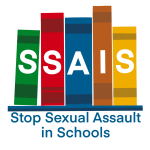 Students are sick of sexual harassment, unwelcome touching, and sexual assault that infect what should be a safe learning environment. Sex-based harassment causes real emotional, psychological, and economic damage to students. Victims are often forced to attend classes with perpetrators of sexual harassment and violence. Feeling uncomfortable and unsafe at school correlates with declining academic performance, skipping school, and dropping out. Some students never “get over it;” they take their own lives.
Students are sick of sexual harassment, unwelcome touching, and sexual assault that infect what should be a safe learning environment. Sex-based harassment causes real emotional, psychological, and economic damage to students. Victims are often forced to attend classes with perpetrators of sexual harassment and violence. Feeling uncomfortable and unsafe at school correlates with declining academic performance, skipping school, and dropping out. Some students never “get over it;” they take their own lives.
Although schools are required under Title IX to proactively address sexual harassment and violence at school, they rarely do. That’s why SSAIS is spearheading a national movement to address K-12 sexual violence by raising awareness, helping families file complaints with the U.S. Department of Education, and encouraging activism through its Activism Toolkit.
SSAIS has been following the exemplary activism of Berkeley High School Stop Harassing (BHSSH) group since December 2014 and has spotlighted their work. Here’s a great introductory video capturing the group’s award-winning efforts. This month, BHSSH has enacted a Story-A-Day campaign in which school board directors receive a daily account of sexual harassment. We reached out to BHSSH Adult Advisor, Heidi Goldstein, to share her experience for the benefit of students nationwide.
SSAIS: Heidi, can you provide a brief overview of the organization?
Heidi: BHS Stop Harassing (BHSSH) is a student-led grass roots movement that originated in Berkeley, CA in the autumn of 2014 due to student outrage over a Berkeley High School administrator’s remarks at multiple back-to-school assemblies that equated how girls dressed with how they could expect to be treated with respect to sexual harassment.
BHSSH started as a handful of energized students sitting around a kitchen table talking about the culture of harassment at their high school. It has evolved to become an organization (not a school club) that meets regularly to pursue advocacy and actions to change the culture of sexual violence and harassment in the Berkeley Unified School District. In June 2015 BHSSH was recognized by the national Title IX advocacy organization, Equal Rights Advocates, at their annual gala as their 2015 “Champions of Justice.” Earlier this year the group was honored with a prize and stipend from the Futures Without Violence Respect Challenge Grant. BHSSH can be found on Instagram and Facebook
SSAIS: What can parents do when students are sexually harassed at school?
Heidi: First and foremost, stand by your student and get them the help they want to feel safe at school and reassured that you’ve got their back. Understand that school districts approach incidents of sexual harassment, battery or assault as risk management problems; they will do what they can to minimize their exposure and liability and make your problem go away. Your student’s needs are secondary to this in their schema.
After an incident parents need to connect immediately with the school site administrator — typically the Principal — and the school district Compliance Officer or Title IX Coordinator to determine next steps. If the school district doesn’t have a Compliance Officer, Title IX Coordinator or other employee explicitly tasked with these responsibilities, parents should insist on a meeting as soon as possible with the Superintendent, who is ultimately accountable for these issues.
SSAIS: In our district, an inadequately trained Title IX Coordinator abdicated responsibility to the school district’s attorney, a clearly prohibited conflict. What else can families expect?
Heidi: Some school districts immediately bring their attorney into the mix. You can’t prevent this and you may not have the resources, or wish, to hire an attorney to represent you, but you can insist that district staff participate in a meeting along with their attorney and that they explain to you — and provide in writing — how their policy applies to the incident and how the incident will be investigated and documented. They should also describe how and when this information will be communicated to you and how decisions will be made regarding your student’s ongoing safety at school. You will also want to know about any processes in place to appeal decisions. They should provide to you the Board Policy (BP) and companion Administrative Regulation (AR) that govern such incidents.
Parents should be very clear on the remedy they want for their student (example: require the harasser or assailant to transfer out of their student’s class to minimize further exposure) and put this in writing using the district’s formal reporting or complaint processes, which typically require the district to respond to you in writing at regular intervals on their progress and findings. It is often challenging to make the school district step up to its responsibilities so frequent follow up and repetition of your expectations is critical to making progress, as is your ability to push hard on issues of disclosure.
Finally, using social media, neighborhood email lists, word of mouth, or PTA contacts, parents should seek out others who have been through this same circumstance. These folks understand what you are going through and can offer good support; their advice is valuable and may help you to avoid delays and unsatisfactory outcomes.
SSAIS: What are some of the problems families face when holding schools accountable?
Heidi: Both schools and school districts have the opportunity to be accountable – or not – when an incident occurs. Typically it is the policies and practices defined by the school district that drive the activities of the administrative staff at the school where the incident occurred. Often school staff work in consultation with school district staff when an incident occurs. Whether by design or due to other factors, such as lack of staff training, the biggest accountability problem by far is lack of follow-up to an incident.
This can manifest as a lack of clarity as to who is “in charge” of responding to the incident, handling the investigation, making decisions around safety or discipline, or communicating with parents/students about progress and findings. Sometimes this presents as a constantly changing cast of characters who are charged with responding or making decision. Sometimes the point of contact assigned to the parents/students is a school district representative who cannot make decisions and who is not involved in the investigation or resolution of the incident. All these approaches put an excessive burden on parents/students to get clear information about what is happening.
Another problem is getting clear information about the school’s investigation of an incident as administrators often cite privacy laws – specifically FERPA (for students) and union covenants (for staff) – as the basis for not sharing any information. It is worth pushing back hard on this as school districts generally take a conservative stance on these issues but it is possible to share many elements of the findings without direct violation of privacy protections. A frequent and unfortunate fall back for school districts to avoid accountability is to claim that their attorneys have told them they cannot share “privileged” information. This stance leaves complaining parents little choice but to pursue public records disclosure requests, also an undue burden.
Some schools or school districts skirt accountability by using “railroading” tactics such as telling complaining parents or students that the matter is being handled and there is no further need for their involvement – and then ceasing all activity around the incident. A truly unfortunate practice I have personally experienced is “jamming,” where a decision to be enacted on the following Monday was communicated to me via email just at the close of business on the prior Friday afternoon, leaving limited options to get in touch with authorized school district personnel to appeal the decision.
SSAIS: Yes, a school district will often shirk its responsibility to conduct a prompt independent inquiry by saying that “law enforcement is investigating,” even though Title IX specifies that schools must investigate concurrently. Often schools wrongly claim they have no further responsibility because the perpetrator wasn’t prosecuted. Title IX is very clear that schools must take specific steps to investigate and remedy the hostile environment.
What are other ways you’ve seen a school district minimize or dismiss complaints?
Heidi: There are school districts that rely on the fact that parents are too busy with their jobs or other responsibilities, or are unable to take time off to follow up on incidents; and that these parents/students lack knowledge of their rights or the skills (including basic communication skills for immigrant parents and students whose first language is not English) to insist on school district accountability. Along with this is a practice of schools leveraging, where they have the opportunity, cultural traditions that hesitate to challenge authority when a decision is communicated, even if the affected parties disagree with it. This is particularly true of first generation immigrant families and those with undocumented family members.
SSAIS: We also see a similar problem in small communities where the perpetrator’s family is involved in the school administration, athletics, or law enforcement. Those who bring their complaints forward do so at considerable peril. The work of BHSSH provides solidarity and inspiration to those who are isolated after reporting their assaults.
How have the BHSSH students benefitted from their advocacy efforts?
Heidi: The students of BHSSH have benefited from exposure to a wide range of experiences and opportunities that will forever influence their understanding of their ability to make a difference in the world. They are well respected by their peers and teachers for both their advocacy work and their knowledge of the universe of issues around sexual harassment.
Through their work they have met with national players in the fight for equity on college campuses as well as with researchers in academia and the not-for-profit social services sphere. They have briefed local leaders (including the Berkeley Commissions on the Status of Women, and Peace and Justice) on the issues and the nature of their advocacy work and have both attended and presented at conferences. They regularly speak before the Berkeley School District Board of Directors and give interviews to radio, television and print media outlets. They have published their own writings about sexual harassment advocacy and have made multiple videos on the topic.
BHSSH students have hands-on experience in developing and running campaigns to educate and give voice to student experiences that would otherwise be unheard. They are about to publish a set of trauma-informed tools to facilitate student reports of harassment, replacing the school district’s overly complicated and opaque materials. These experiences and activities have deepened their empathy for others in highly charged and complicated circumstances and have enabled them to construct a nuanced understanding of how change is made. It is my privilege to serve as an adult advisor to this next generation of leaders and thinkers in this sphere of social activism.
Check out the SSAIS Get Involved and Activism Toolkit pages to find an activity that’s right for you.
